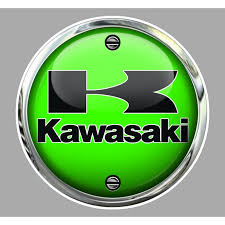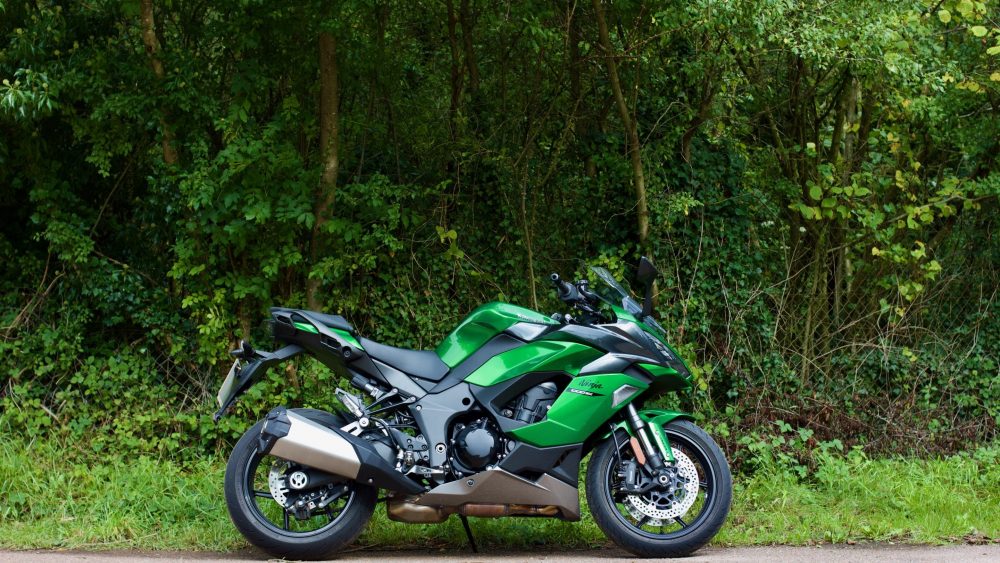
Can Kawasaki’s updated Sports-Touring stalwart win over a V-Strom fanboy?
Kawasaki’s Z1000SX has been a best-seller for the brand ever since it launched in 2011. It almost single-handedly breathed life into the dying sports-tourer genre of motorcycling, offering ageing sports bike enthusiasts an alternative to the unstoppable adventurer-tourer juggernaut. Of course, it wasn’t perfect, and has been revised every couple of years since with nips and tucks to keep customers happy. Now the evergreen bike has been re-branded the Ninja 1000SX, and has received a plethora of upgrades to match. Is it enough to tempt my fancy?
A first-generation Kawasaki Z1000SX actually made it onto the same shortlist as the freshly-updated Triumph Street Triple R, the bike I eventually purchased in 2013. Back then my criticisms were that it was expensive and heavy, and I was keen to try something light and flickable after my 250kg Suzuki Bandit 650S. But all the reasons I considered it then are still true today, and at £12,000 on the road for the Tourer model it’s downright reasonable compared to some of its increasingly expensive competition.
A shame then that it’s still a 235kg proposition, a mass figure that’s quite apparent when wheeling the bike around for photographs – and that doesn’t include the 56 litres of included waterproof plastic panniers that clip neatly onto the integrated luggage racks. You could save yourself £1,000 and choose the standard bike, but alongside those boxes you’d also lose the taller touring screen, tank pad and heated grips. The version I was given to ride for this review lacked all of those extras, but they’re certainly features I’d want on my long-distance touring motorcycle.
What has changed in the last decade is that motorcycle user interfaces have become significantly more sophisticated. Tucked away in the Ninja’s fairing is a neat little full-colour computer screen, providing more information than most people would ever want about their ride. The basics are all there – speed, tachometer, gear position – alongside some more modern content such as average and instant fuel consumption. Toggle through the display and you can also find some truly nerdy delights such as battery voltage and highest-recorded lean angle. You can even set the display to show you your current lean angle in real-time, a feature that is almost guaranteed to result in a spectacular crash!
While the right-hand switch cluster holds nothing more than an integrated starter/kill-switch, the left cluster has been hoarding the remaining buttons. Not only can you control every aspect of the dashboard from here, you can also activate this bike’s new killer feature – electronic cruise control. Z1000SX owners have been clamouring for this feature for years, and the best compliment I can give is that it works exactly as intended. What’s also new is the two-way quick-shifter, allowing you to change up and down through the gearbox without touching the clutch. Usually, I find these systems tend to disappoint, working only at high revs and at wide-open-throttle, but Kawasaki have clearly spent a significant amount of time calibrating their implementation. Any gear, any engine or road speed, any throttle opening – it just works seamlessly.
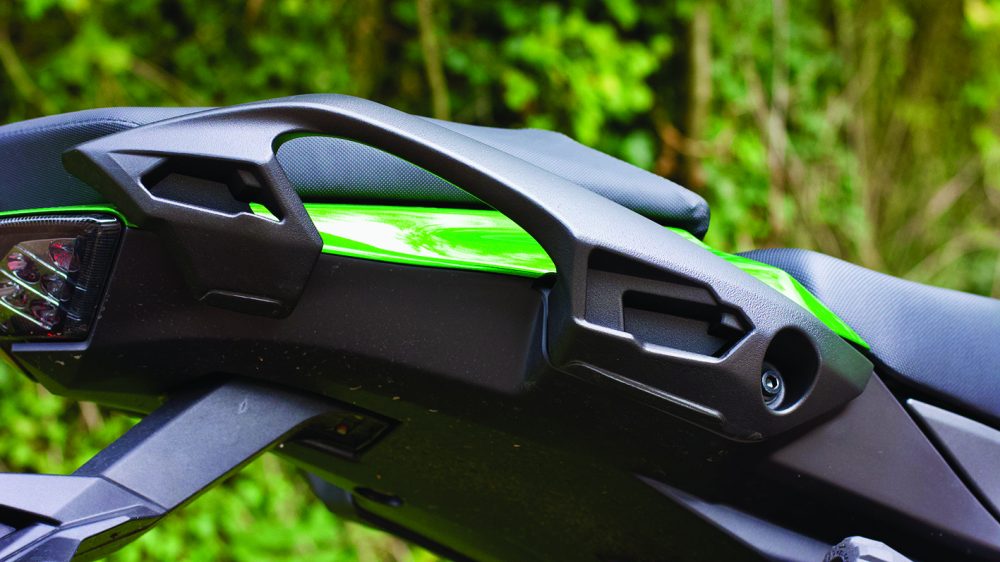
Passenger grab rails incorporate the mounting lugs for the 28-litre hard panniers.
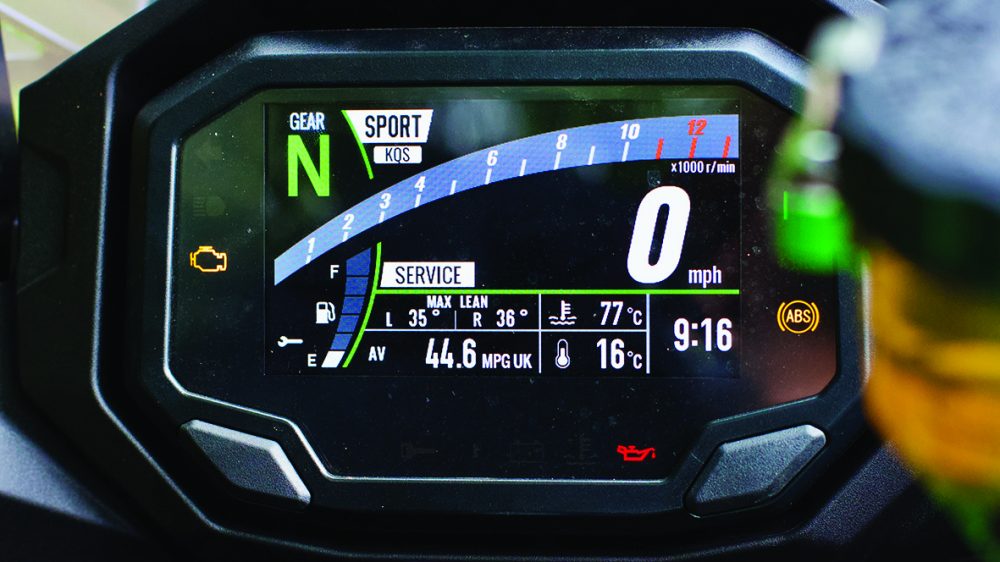
Not as big and beautiful as BMW’s, but Kawasaki’s TFT dashboard is well designed.
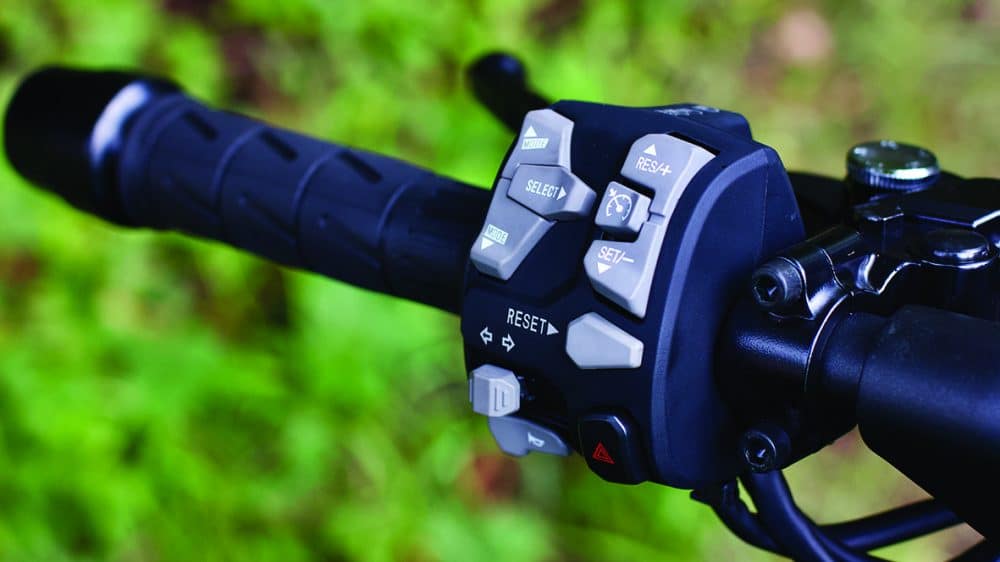
So many buttons on the left cluster, and yet only a single switch on the right.
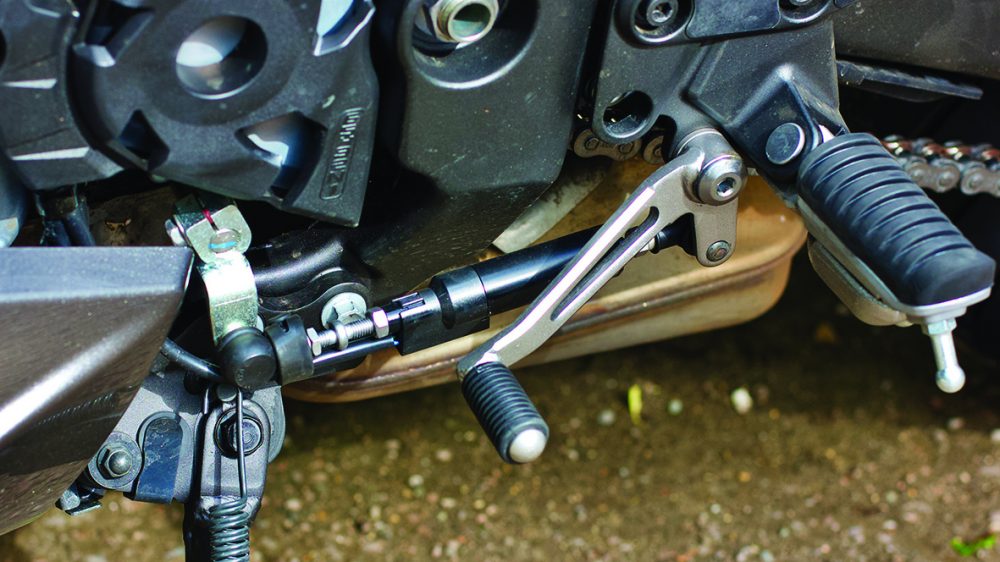
Quick-shifter works flawlessly up and down the gears; it’s genuinely useful.
Fuelling is ever-so-slightly fluffy at low revs when cold, but the engine quickly shakes off any cobwebs and provides entirely linear drive as you trundle through town. There’s no drama, it’s all very civilised, with no trace of the low-rev jerkiness I’ve come to associate with big-power motorcycles. What’s more, you can choose pretty much any gear you wish for this job – even sixth works just fine, the 1,043cc in-line four responding without hesitation or complaint to any request at any speed. Kawasaki could have left the engine modes on the drawing board and just reminded their customers that the gearbox will do the same job of modulating rear-wheel torque just fine.
Once opportunities to make progress appear, you might expect me to report that a twist of the wrist transforms the docile steed into a snarling, raging monster – but that simply never happens. I did find that you can provoke a slight head-shake through judicious throttle application in first gear, but the sophisticated traction control systems quickly bring things under control. Perhaps disabling some of these safety features would add a little terror to your day, but the only thing that makes the default bike scary is when you look down at the speedo and realise that you’re going a lot faster than you thought you were.
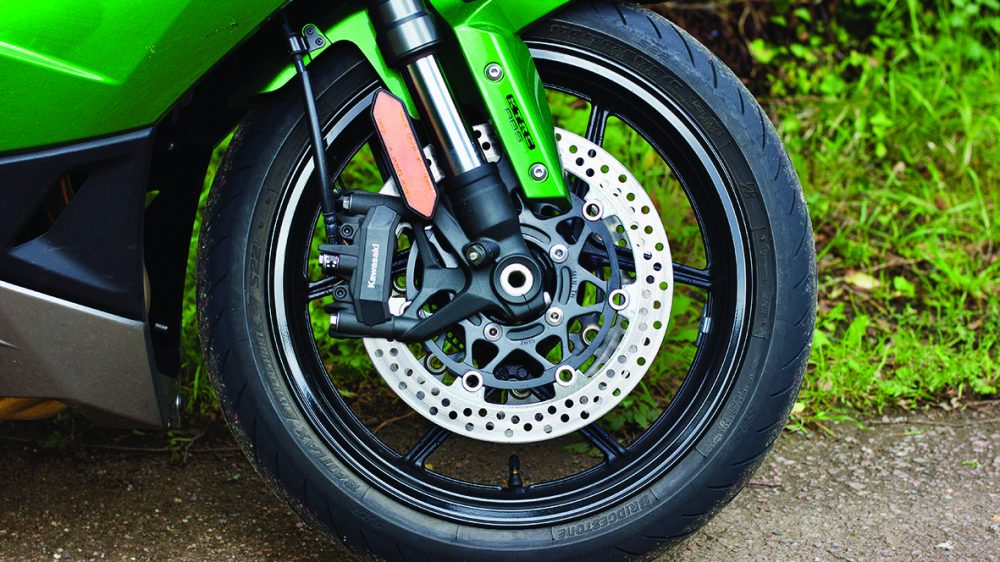
The brakes are excellent; the suspension sublime.
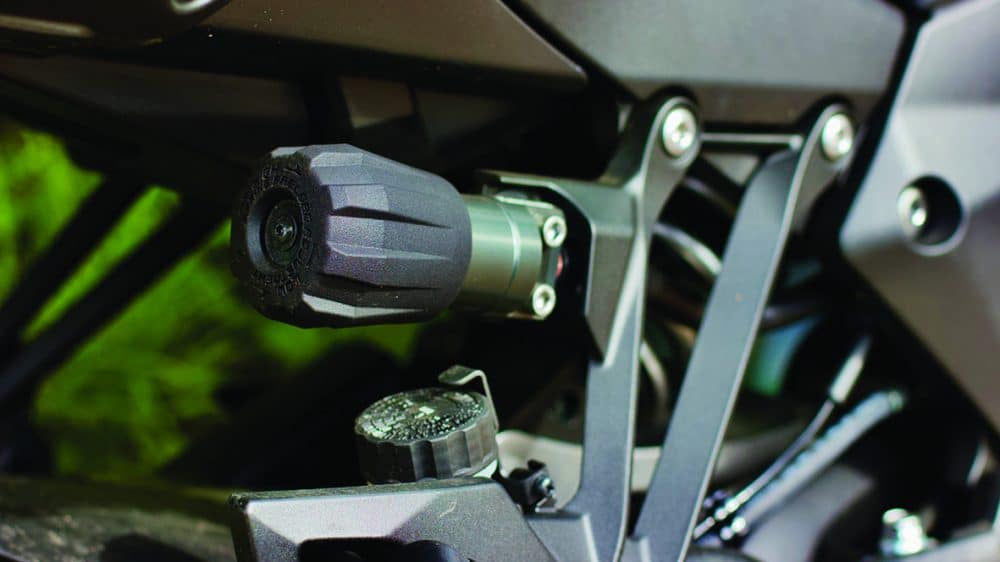
Rear shock preload can be adjusted easily to cope with luggage or passengers.
It’s deceptive. Whereas other bikes let you know you’re going fast through noise or vibration, the Ninja simply hums along quietly as you smoothly build speed. It’s almost as though Kawasaki have found a way to dampen inertia itself – you twist the throttle, and the tiniest moment later you are simply going faster. A lot faster. It’s just as well that the Kawasaki-branded mono-block four-piston brakes are so good, because you’ll want to know you can safely and quickly scrub off any excess speed before the next corner arrives. Overall, it’s honestly hard to judge your speed because it’s just all so eerily smooth…which is also when you first notice just how astonishingly good the suspension is.
You see, the way I can usually tell that I’m going too fast on most motorcycles is when I’m holding on to the handlebars for dear life while being bounced out of the seat. When I upgraded the suspension on my V-Strom I initially thought I’d wasted my money because nothing seemed to have changed…until I checked my speedometer. Good suspension does that – it lets the useful information from the road surface through while filtering out all of the noise and sharp edges that unsettle both rider and chassis. You should know that there was a nasty bump there without actually getting…well, bumped, and can instead focus on maintaining smooth, fast lines.
The trade-off for slightly softer, more compliant suspension is that you lose some handling precision. It’s the same on my V-Strom – at very high speeds you start to notice just a touch of vagueness, and the chassis seems to take a little longer to settle itself after big inputs – from yourself, or from the road. While the Ninja 1000SX enables a fast, smooth riding style, it also requires it. There’s no defying physics here – a 235kg motorcycle cannot be forced to react like a 190kg Supersport, and you won’t be flicking the big Ninja from side to side like a ZX-6R. It’s not exactly ponderous, nor are brakes or acceleration noticeably blunted by the extra mass as on some bikes I’ve ridden. I suspect that you’d want to tighten up the damping somewhat before your next trackday, but here in the real world, on real roads, it’s a compromise I welcome with open arms.
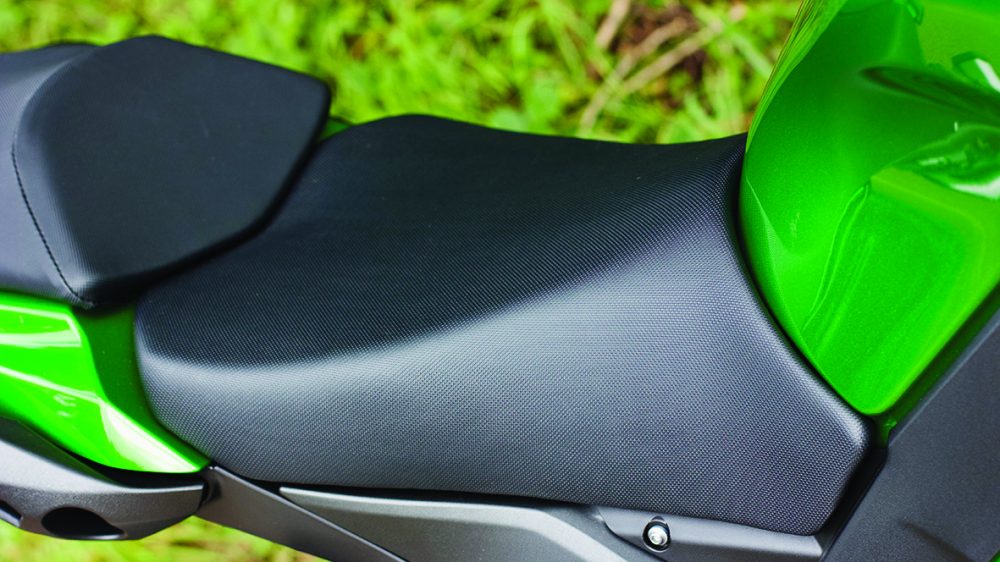
Wide, plush, comfortable – one of the best seats in motorcycling.
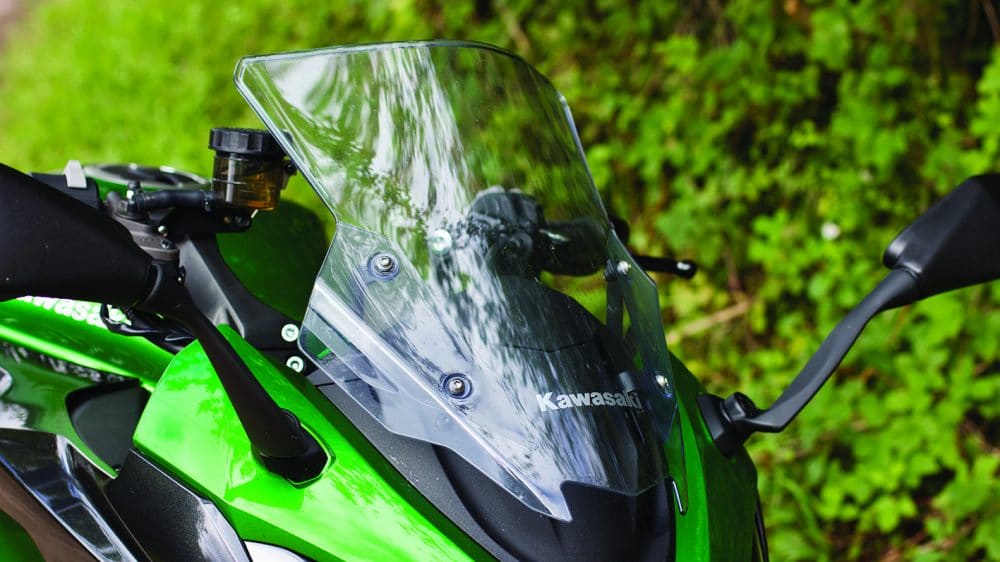
Tilt-adjustable windshield delivers good results in any position. Touring version is taller.
Supporting both the suspension and indeed my bony backside is one of the most comfortable motorcycle seats I’ve ever spent time on. In an era of narrow, scalloped designs prioritising low height over long-haul comfort, the Ninja’s seat is defiantly wide and plush. Another tricky area, wind protection, has also been resolved without apparent difficulty by Kawasaki’s engineers. The standard windshield can be manually adjusted for angle, and all positions result in a flow of quiet, clean air to my helmet. When so many stock windshields go in the bin on day one due to horrendous buffeting, Kawasaki should be commended for getting this part right straight from the factory.
What else is there to say? The wing mirrors are excellent, and even fold in neatly on a spring-loaded mechanism, allowing you to pop them back into position in seconds should you need to squeeze through a tight spot. Every light on the bike is LED, and the front indicators are even neatly faired-in for improved aerodynamics. You get a hydraulic preload adjuster on the rear shock for when you’re carrying a pillion or have over-filled those panniers, and both front and rear suspension is fully adjustable. Yes, you have to fetch your screwdrivers and do it yourself, but given how good the out-of-the-box setup is, that’s honestly not a problem.
There’s also no way to mount a centre stand, as Kawasaki have filled that space with an ugly under-body exhaust silencer. Maintaining the drive chain would require a paddock stand at home, and an automatic chain oiler may be worth considering for solo tourists. Further still, because the Ninja 1000SX is technically a new product in the eyes of the insurance industry, the quotes I received were 50% more than an identical Z1000SX from the same insurers. Once the algorithms figure out that we’re no more likely to crash this new bike than the old one, prices should theoretically level out.
If I wanted to nit-pick I’d question Kawasaki’s mounting of the rear brake caliper underneath the swingarm where it will surely seize solid in winter salt. But they’ve been mounting it there since the 80’s, so maybe they know something I don’t. It does mean that paddock-stand lugs are set quite far forward, which might cause clearance issues for some stands. And I’m always going to wish they’d found a way to take 20kg out of the wet weight without compromising load capacity, but I guess that’s a trade-off I’ll have to accept. The dashboard screen is a little small perhaps, and I do worry that it will look out-of-date long before the rest of the bike does. And when everyone else is spoiling us with gold-anodized Nissins or big-block Brembos, the black Kawasaki-branded brakes look a little down-market. But honestly, these really are minor complaints.
No, the only big issues with this bike lie with its motor, and it’ll be up to each individual to decide if it’s a big enough fly to spoil the ointment. First up, my perennial bug-bears of fuel economy and it’s sibling fuel range. 19 litres of petrol seems like a reasonable amount until you look at www.fuelly.com and realise that 45 mpg (UK) appears to be average for this engine. That means around 180 miles to empty, with the low-fuel warning light coming on at just 150 miles or less. What’s softened my stance on this issue recently is the results of my research into long-term running costs, and determining that an extra 10 mpg really wouldn’t save you that much money, even over 100,000 miles. Maybe fuel prices will suddenly spike to £5 per litre and we’ll all switch to Honda PCXs, but otherwise it’s unlikely that many others will notice or care.
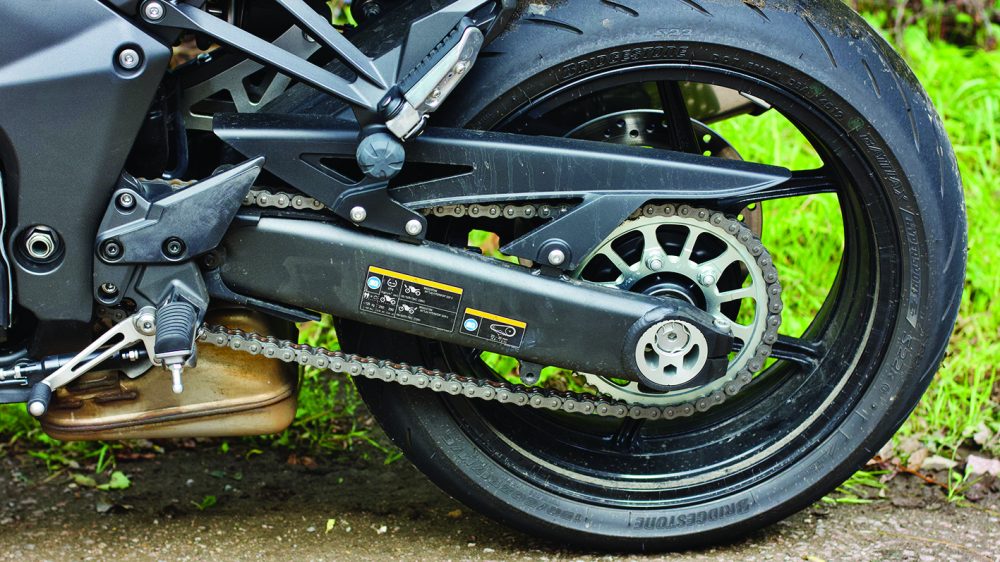
Paddock stand mounting lugs are forward, rotating chain adjuster is unique.
The second issue with the motor is down to the complexity and how it’s installed in the motorcycle. Kawasaki quote £400-£600 for minor/major services, and an additional £400 to check the valve clearances – more still if they need adjusting. That big engine is buried under bodywork, hoses, and wiring, and takes a long time to dig out. Combined with the poor fuel economy the Ninja 1000SX becomes one of the most expensive motorcycles to own long-term. It could be worse – valve checks only need performing every 26,000 miles, and if you’re comfortable handling oil and filter changes yourself you could save a lot of money while still leaving the really tricky tasks to the professionals. Still, that’s modern motorcycles for you – high performance, features, and reliability make for complex machinery. One more reason to look forward to electric motorcycles, perhaps?
The final issue with the motor is that it’s a little too good at its job. In-line fours have always prioritised high power-per-displacement ratios – it’s the boring choice, but it delivers results. Interesting inline-fours have existed in both cars and motorcycles in the past, but noise regulations have smothered raucous induction tones and made high-revving screamers impossible. The fact is that noise and vibration are waste products, energy not being used to drive you forward.
And while I still very much enjoy the aural sensations of an internal combustion engine, the tides are turning against us, with whole stretches of road in Germany and Austria now off-limits to all but the quietest bikes. The 1,043cc engine in the Ninja 1000SX has been around since 2003 in various forms, but it’s now so quiet and refined that I can’t imagine an all-electric drivetrain being that much different to experience. There’s a little more mechanical noise at very high revs, but it’s not really something you’d go chasing for aural pleasure.
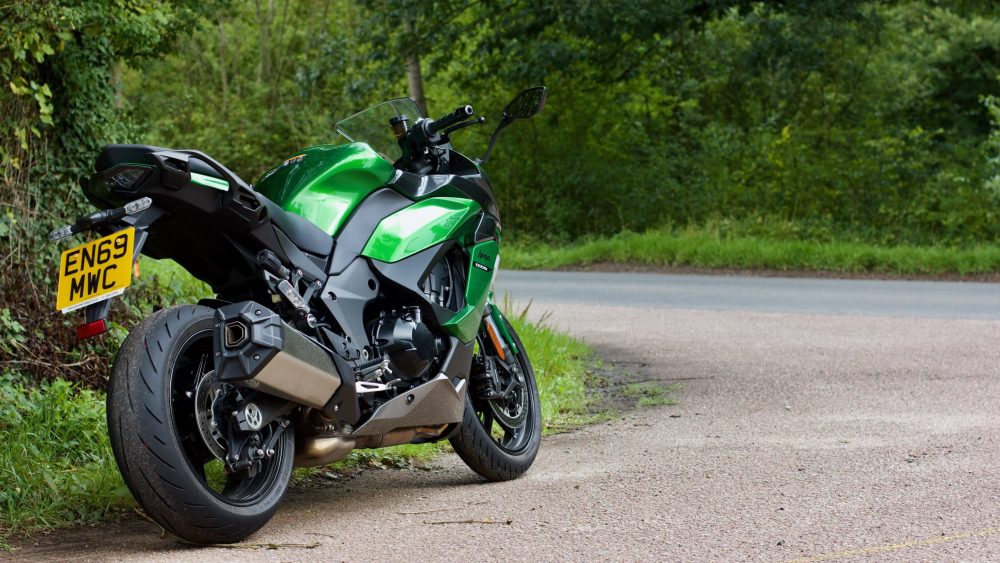
Maybe you’d get used to it. Maybe you’d modify the airbox, swap out the exhaust, and liberate a little of that early-2000’s Superbike sound. Or maybe smooth, quiet efficiency is exactly what you’re after. Maybe you don’t want a torque curve littered with spikes that send the front wheel skyward when the engine comes on-cam. Maybe you just want to cross continents in speed and comfort, and then embarrass noisier, flashier riders as you overtake them on the outside of a corner while waving nonchalantly at them. If that sounds like your cup of tea, then the Ninja 1000SX might be just the bike you’ve been looking for.
I rode home after returning the Ninja on my de-baffled V-Strom, air-box and exhaust roaring a rousing symphony every time I slammed the throttle wide open for another overtake. It’s something I’d certainly miss were I to swap a mid-capacity 90-degree twin for a turbine-smooth inline-four. But the rest of the package is just so damn good that I may well forgive it this one flaw and learn to enjoy a different type of motorcycling for a while.
Nick Tasker
First published in Slipstream October 2020

